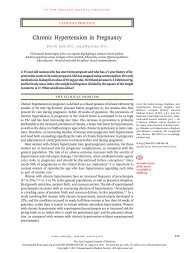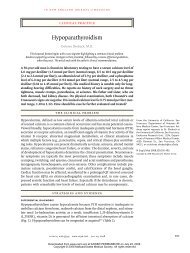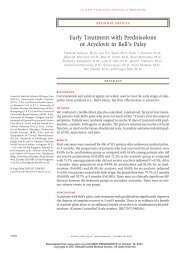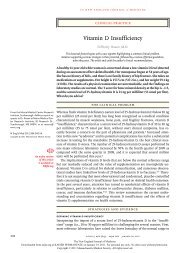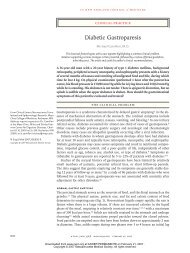Cervical radiculopathy - enotes - Q-Notes for Adult Medicine
Cervical radiculopathy - enotes - Q-Notes for Adult Medicine
Cervical radiculopathy - enotes - Q-Notes for Adult Medicine
Create successful ePaper yourself
Turn your PDF publications into a flip-book with our unique Google optimized e-Paper software.
The new england journal of medicineclinical practice<strong>Cervical</strong> RadiculopathySimon Carette, M.D., M.Phil., and Michael G. Fehlings, M.D., Ph.D.This Journal feature begins with a case vignette highlighting a common clinical problem.Evidence supporting various strategies is then presented, followed by a review of <strong>for</strong>mal guidelines,when they exist. The article ends with the authors’ clinical recommendations.A 37-year-old woman presents with a two-week history of severe neck pain radiatingto her left shoulder girdle and extending to the arm, <strong>for</strong>earm, and dorsum of the hand.She reports having had no fever, weight loss, leg weakness, or urinary or bowel dysfunction.Physical examination reveals weakness of her left triceps, finger extensors,and wrist flexors, as well as hypoesthesia of the third digit and a diminished triceps reflex.How should her case be managed?the clinical problemFrom the Divisions of Rheumatology (S.C.)and Neurosurgery (M.G.F.), Toronto WesternHospital, University Health Network;and the Departments of <strong>Medicine</strong> and Surgery,University of Toronto (S.C., M.G.F.) —all in Toronto. Address reprint requests toDr. Carette at Toronto Western Hospital,EW1-422, 399 Bathurst St., Toronto, ONM5T 2A8, Canada, or at simon.carette@uhn.on.ca.N Engl J Med 2005;353:392-9.Copyright © 2005 Massachusetts Medical Society.<strong>Cervical</strong> <strong>radiculopathy</strong> is a neurologic condition characterized by dysfunction of a cervicalspinal nerve, the roots of the nerve, or both. It usually presents with pain in theneck and one arm, with a combination of sensory loss, loss of motor function, or reflexchanges in the affected nerve-root distribution. 1epidemiologyPopulation-based data from Rochester, Minnesota, indicate that cervical <strong>radiculopathy</strong>has an annual incidence rate of 107.3 per 100,000 <strong>for</strong> men and 63.5 per 100,000 <strong>for</strong>women, with a peak at 50 to 54 years of age. 2 A history of physical exertion or traumapreceded the onset of symptoms in only 15 percent of cases. A study from Sicily reporteda prevalence of 3.5 cases per 1000 population. 3Data on the natural history of cervical <strong>radiculopathy</strong> are limited. 2,4-6 In the population-basedstudy from Rochester, Minnesota, 26 percent of 561 patients with cervical<strong>radiculopathy</strong> underwent surgery within three months of the diagnosis (typically <strong>for</strong>the combination of radicular pain, sensory loss, and muscle weakness), whereas theremainder were treated medically. 2 Recurrence, defined as the reappearance of symptomsof <strong>radiculopathy</strong> after a symptom-free interval of at least 6 months, occurred in32 percent of patients during a median follow-up of 4.9 years. At the last follow-up, 90percent of the patients had normal findings or were only mildly incapacitated owing tocervical <strong>radiculopathy</strong>.causes and pathophysiological featuresThe most common cause of cervical <strong>radiculopathy</strong> (in 70 to 75 percent of cases) is <strong>for</strong>aminalencroachment of the spinal nerve due to a combination of factors, including decreaseddisc height and degenerative changes of the uncovertebral joints anteriorly andzygapophyseal joints posteriorly (i.e., cervical spondylosis) (Fig. 1). In contrast to disordersof the lumbar spine, herniation of the nucleus pulposus is responsible <strong>for</strong> only20 to 25 percent of cases. 2 Other causes, including tumors of the spine and spinal infections,are infrequent. 7The mechanisms underlying radicular pain are poorly understood. Nerve-rootcompression by itself does not always lead to pain unless the dorsal-root ganglion is392n engl j med 353;4 www.nejm.org july 28, 2005Downloaded from www.nejm.org at KAISER PERMANENTE on July 28, 2005 .Copyright © 2005 Massachusetts Medical Society. All rights reserved.
clinical practiceABHypertrophy ofuncovertebral jointHypertrophy ofzygapophyseal jointSpinalganglionHerniation ofnucleus pulposusSpinal nerve07/28/05Herniateddisk andosteophyticspur at C6–C7Spinal cordSuperiorarticularprocessC<strong>Cervical</strong> vertebraHerniateddisk andosteophyticspur at C6–C7Figure 1. Causes of <strong>Cervical</strong> Radiculopathy.Foraminal encroachment of the spinal nerve from degenerative changes in the uncovertebral and zygapophyseal joints and herniation of thenucleus pulposus are the two most common causes of cervical <strong>radiculopathy</strong> (Panel A). T 2 -weighted magnetic resonance imaging in a sagittalview (Panel B) and axial view (Panel C) shows a herniated disk and an osteophytic spur at C6–C7 paracentral to the left side with compressionof the exiting C7 nerve root. There is no evidence of spinal cord compression.also compressed. 8,9 Hypoxia of the nerve root anddorsal ganglion can aggravate the effect of compression.10 Evidence from the past decade indicatesthat inflammatory mediators — includingmatrix metalloproteinases, prostaglandin E 2 , interleukin-6,and nitric oxide — are released byherniated cervical intervertebral disks. 11-13 Theseobservations provide a rationale <strong>for</strong> treatment withantiinflammatory agents. 14 In patients with diskherniation, the resolution of symptoms with nonsurgicalmanagement correlates with attenuationof the herniation on imaging studies. 15-18strategies and evidenceclinical diagnosisThere are no universally accepted criteria <strong>for</strong> thediagnosis of cervical <strong>radiculopathy</strong>. 19 In most cases,the patient’s history and physical examinationare sufficient to make the diagnosis. 20 Typically,patients present with severe neck and arm pain. Althoughthe sensory symptoms (including burning,tingling, or both) typically follow a dermatomal distribution,the pain is more commonly referred in amyotomal pattern. 2,21 For example, radicular painfrom C7 is usually perceived deeply through theshoulder girdle with extension to the arm and <strong>for</strong>earm,whereas numbness and paresthesias are morecommonly restricted to the central portion of thehand, the third digit, and occasionally the <strong>for</strong>earm.Subjective weakness of the arm or hand is reportedless frequently. Holding the affected arm on top ofthe head 22 or moving the head to look down andaway from the symptomatic side often improvesthe pain, whereas rotation of the head or bending ittoward the symptomatic side increases the pain. 23Guidelines developed by the Agency <strong>for</strong> HealthCare Policy and Research <strong>for</strong> the assessment ofn engl j med 353;4 www.nejm.org july 28, 2005393Downloaded from www.nejm.org at KAISER PERMANENTE on July 28, 2005 .Copyright © 2005 Massachusetts Medical Society. All rights reserved.
The new england journal of medicinelow back pain may be applied to the patient withneck pain and <strong>radiculopathy</strong>. 24 The presence of“red flags” in the patient’s history (including fever,chills, unexplained weight loss, unremitting nightpain, previous cancer, immunosuppression, or intravenousdrug use) should alert clinicians to thepossibility of more serious disease, such as tumoror infection. Clinicians should also inquire aboutsymptoms of myelopathy. These may occasionallybe subtle (e.g., diffuse hand numbness and clumsiness,which are often attributed to peripheral neuropathyor carpal tunnel syndrome; difficulty withbalance; and sphincter disturbances presenting initiallyas urinary urgency or frequency rather than asretention or incontinence).Findings on physical examination vary dependingon the level of <strong>radiculopathy</strong> and on whetherthere is myelopathy (Tables 1 and 2). In most series,the nerve root that is most frequently affected is theC7, followed by the C6. 2 Many provocative testshave been proposed <strong>for</strong> the diagnosis of cervical<strong>radiculopathy</strong>, but the reliability and diagnostic accuracyof these tests are poor. 19,25Several conditions can mimic cervical <strong>radiculopathy</strong>and should be ruled out by history takingand physical examination, occasionally supplementedby imaging, electrophysiological studies,or both 26 (Table 3).laboratory studiesLaboratory studies are of limited value and are notrecommended. The erythrocyte sedimentation rateand C-reactive protein levels are elevated in manypatients with spinal infection or cancer, but thesetests are not sufficiently sensitive or specific to guidefurther evaluation.imagingConventional radiographs of the cervical spine areoften obtained, but their usefulness is limited. 31This is due to the low sensitivity of radiography<strong>for</strong> the detection of tumors or infections, as wellas its inability to detect disk herniation and thelimited value of the finding of cervical intervertebralnarrowing in predicting nerve-root or cordcompression. 32Magnetic resonance imaging (MRI) is the approachof choice when imaging is pursued in patientswith cervical <strong>radiculopathy</strong> (Fig. 1), 33 butthere are currently no clear guidelines regardingwhen such imaging is warranted. Reasonable indicationsinclude the presence of symptoms or signsof myelopathy, red flags suggestive of tumor orinfection, or the presence of progressive neurologicdeficits. For most other patients, it is appropriateto limit the use of MRI to those who remain symptomaticafter four to six weeks of nonsurgical treatment,particularly given the high frequency ofabnormalities detected in asymptomatic adults, includingdisk herniation or bulging (57 percent ofcases), spinal cord impingement (26 percent), andcord compression (7 percent). 34Computed tomography (CT) alone is of limitedvalue in assessing cervical <strong>radiculopathy</strong>, 35 but itcan be useful in distinguishing the extent of bonyspurs, <strong>for</strong>aminal encroachment, or the presence ofTable 1. Physical Findings Associated with <strong>Cervical</strong> Radiculopathy.*Disk Level Root Pain Distribution Weakness Sensory Loss Reflex LossC4–C5 C5 Medial scapular border, Deltoid, supraspinatus, Lateral upper arm Supinator reflexlateral upper arm toelbowinfraspinatusC5–C6 C6 Lateral <strong>for</strong>earm, thumband index fingerBiceps, brachioradialis,wrist extensorsThumb and indexfingerBiceps reflexC6–C7 C7 Medial scapula, posteriorarm, dorsum of<strong>for</strong>earm, third fingerC7–T1 C8 Shoulder, ulnar side of<strong>for</strong>earm, fifth fingerTriceps, wrist flexors,finger extensorsThumb flexors, abductors,intrinsic handmusclesPosterior <strong>for</strong>earm,third fingerTriceps reflexFifth finger —* Provocative tests include the <strong>for</strong>aminal compression test (Spurling maneuver), in which the neck is passively bent towardthe symptomatic side and the examiner applies pressure (approximately 7 kg) to the patient’s head (a positive testreproduces symptoms); the shoulder abduction test, in which the patient is asked to place the hand of the symptomaticarm on the head (a positive test reduces or eliminates symptoms); and the neck distraction test, in which the patient issupine and the examiner, holding the chin and occiput, applies a gradual pulling <strong>for</strong>ce (a positive test reduces or eliminatessymptoms). 25394n engl j med 353;4 www.nejm.org july 28, 2005Downloaded from www.nejm.org at KAISER PERMANENTE on July 28, 2005 .Copyright © 2005 Massachusetts Medical Society. All rights reserved.
clinical practiceossification of the posterior longitudinal ligament.The combination of CT with the intrathecal administrationof contrast material (CT myelography)provides accuracy similar to 36 and possibly superiorto 37 that of MRI, but its invasive nature makesMRI preferable in most cases. Technetium and galliumbone scans are very seldom indicated, except inrare cases in which cancer or infection is suspectedin multiple sites and MRI cannot be readily per<strong>for</strong>medor is impractical.electrodiagnostic studiesNeedle electromyography and nerve-conductionstudies can be helpful when the patient’s historyand physical examination are inadequate to distinguishcervical <strong>radiculopathy</strong> from other neurologiccauses of neck and arm pain. Typically, abnormalinsertional activity, including positive sharp-wavepotentials and fibrillation potentials, is present inthe limb muscles of the involved myotome withinthree weeks of the onset of nerve compression. 38Examination of the paraspinal muscles increasesthe sensitivity of the test, since insertional activitycan be seen as early as 10 days after the nerve injury.In addition, the presence of abnormal findings inparaspinal muscles differentiates cervical <strong>radiculopathy</strong>from brachial plexopathy.treatmentNonsurgical ManagementThe main objectives of treatment are to relievepain, improve neurologic function, and prevent recurrences.39 None of the commonly recommendednonsurgical therapies <strong>for</strong> cervical <strong>radiculopathy</strong>has been tested in randomized, placebo-controlledtrials. Thus, recommendations derive largely fromcase series and anecdotal experience. The preferencesof patients should be taken into account indecision making.On the basis of anecdotal experience, analgesicagents, including opioids and nonsteroidal antiinflammatorydrugs, are often used as first-line therapy.In patients with acute pain, some physicians advocatea short course of prednisone (<strong>for</strong> example,starting at a dose of 70 mg per day and decreasingby 10 mg every day). 39 This practice is supportedonly by anecdotal evidence, however, and is associatedwith potential risks.Retrospective 40,41 and prospective 42,43 cohortstudies have reported favorable results with translaminarand trans<strong>for</strong>aminal epidural injections ofcorticosteroids, with up to 60 percent of patientsTable 2. Physical Findings Associated with Myelopathy.FindingsHyperreflexia; hypertonia; clonus of the ankle, knee, or wrist; pathologicalreflexes or signs, such as the Babinski sign, Hoffmann’s sign (flexionand adduction of the thumb when the examiner flexes the terminalphalanx of the long finger), and Lhermitte’s sign (a sensationof electrical shock radiating down the spine, precipitated by neckflexion)Clinical grading*MildSensory symptoms; subjective weakness; hyperreflexia (with or withoutHoffmann’s sign or the Babinski sign); no functional impairmentModerateObjective motor or sensory signs (a score of >4 out of 5 on the MedicalResearch Council scale); either no or mild functional impairment(e.g., mild slowing of gait)SevereObjective motor or sensory signs with functional impairment(e.g., hand weakness, unsteady gait, sphincter disturbance)* Clinical grading is per<strong>for</strong>med on the basis of the extent of symptoms, signs,and functional impairment.reporting long-term relief of radicular and neckpain and a return to usual activities. However, complicationsfrom these injections, although rare, canbe serious and include severe neurologic sequelaefrom spinal cord or brainstem infarction. 44 Giventhe potential <strong>for</strong> harm, placebo-controlled trials areurgently needed to assess both the safety and theefficacy of cervical epidural injections.Some investigators have advocated the use ofshort-term immobilization (less than two weeks)with either a hard or a soft collar (either continuouslyor only at night) to aid in pain control. 45 Useof a cervical pillow during sleep has also been recommended.However, data are needed to assess thebenefits of these approaches.<strong>Cervical</strong> traction consists of administering adistracting <strong>for</strong>ce to the neck in order to separatethe cervical segments and relieve compression ofnerve roots by intervertebral disks. Various techniques(supine vs. sitting; intermittent vs. sustained;motorized or hydraulic vs. an over-the-door pulleywith weights) and durations (minutes vs. up to anhour) have been recommended. 46,47 However, asystematic review stated that no conclusions couldbe drawn about the efficacy of cervical traction becauseof the poor methodologic quality of the availabledata. 48 Exercise therapy — including activerange-of-motion exercises and aerobic conditioning(walking or use of a stationary bicycle), followedby isometric and progressive-resistive exercises —is typically recommended once pain has subsidedn engl j med 353;4 www.nejm.org july 28, 2005395Downloaded from www.nejm.org at KAISER PERMANENTE on July 28, 2005 .Copyright © 2005 Massachusetts Medical Society. All rights reserved.
The new england journal of medicineTable 3. Conditions with Physical Findings Mimicking Those of <strong>Cervical</strong> Radiculopathy.ConditionPeripheral entrapment neuropathies(e.g., carpal tunnelsyndrome)Disorders of the rotator cuffand shoulderAcute brachial-plexus neuritis(neuralgic amyotrophy orParsonage–Turner syndrome)Thoracic outlet syndromeHerpes zosterPancoast syndromeSympathetically mediatedsyndromesReferred somatic pain fromthe neckFindingsHypoesthesia and weakness in the distribution of the entrapped nerve (e.g., in carpaltunnel syndrome, medial three digits and opponens pollicis; in ulnar entrapment,fourth and fifth digits and thumb adductor); Tinel’s sign and positivePhalen’s maneuver often present in carpal tunnel syndrome; normal reflexes;nerve-conduction studies abnormal in carpal tunnel syndrome but normal incervical <strong>radiculopathy</strong>Pain in the shoulder or lateral arm region that only rarely radiates below the elbowand is aggravated by active and resisted shoulder movements, rather than byneck movements; normal sensory examination and reflexesTypically causes severe pain in neck, shoulder, and arm, which is followed withindays to a few weeks by marked arm weakness, typically in the C5–C6 region, asthe pain recedes 27,28 (unlike in cervical <strong>radiculopathy</strong>, in which pain and neurologicfindings occur simultaneously)Pain in shoulder and arm aggravated by use of the arm; intermittent paresthesia,most commonly in the C8–T1 region (rare in cervical <strong>radiculopathy</strong>); reproductionof symptoms by provocation tests, including Roo’s test (the rapid flexionand extension of fingers while the arms are abducted at 90° and externally rotated90°); neurologic examination usually normal; decreased radial pulse if associatedwith vascular compression (rare); nerve-conduction studies usuallynormalNeuropathic pain in a dermatomal distribution, followed within several days by theappearance of the typical vesicular rashPain in shoulder and arm due to compression of the brachial plexus; paresthesiaand weakness in the C8–T1 region (intrinsic hand muscles); ipsilateral ptosis,myosis, and anhydrosis (Horner’s syndrome)Diffuse pain and burning in arm and hand associated with swelling, hyperesthesia,allodynia, and vasomotor changes (temperature and color); neurologic examinationusually normalPain referred from cervical structures, including the intervertebral disks and zygapophysealjoints, that is usually felt in a segmental distribution (i.e., structuresfrom the C5–C6 level, posterior neck, and supraspinatus fossa; C6–C7 level, supraspinatusfossa and scapula). Unlike in cervical <strong>radiculopathy</strong>, the pain israrely felt below the elbow and the neurologic examination is normal 29,30in order to reduce the risk of recurrence, althoughthis recommendation is not supported by evidencefrom clinical trials. 39surgeryIn appropriate patients, surgery may effectively relieveotherwise intractable symptoms and signs relatedto cervical <strong>radiculopathy</strong>, although there areno data to guide the optimal timing of this intervention.4,5 Commonly accepted indications <strong>for</strong> surgerydiffer depending on whether the patient hasevidence of <strong>radiculopathy</strong> alone or whether thereare also signs of spinal cord impairment, since thelatter can lead to progressive and potentially irreversibleneurologic deficits over time.For cervical <strong>radiculopathy</strong> without evidence ofmyelopathy, surgery is typically recommended whenall of the following are present: definite cervicalrootcompression visualized on MRI or CT myelography;concordant symptoms and signs of cervical-root–relateddysfunction, pain, or both; and persistenceof pain despite nonsurgical treatment <strong>for</strong>at least 6 to 12 weeks or the presence of a progressive,functionally important motor deficit. Commonsurgical procedures <strong>for</strong> cervical <strong>radiculopathy</strong> areshown in Figure 2. 49 Randomized trials are lackingto compare these approaches.Surgery is also recommended in cases in whichimaging shows cervical compression of the spinalcord and there is clinical evidence of moderateto-severemyelopathy (Table 2). For such patients,anterior approaches (preferred in patients with acervical kyphosis) include cervical diskectomy andcorpectomy (removal of the central portion of thevertebral body) alone or in combination at singleor multiple levels. Anterior decompression is generallycombined with a strut reconstruction (bridgingthe space between the end plates of the verte-396n engl j med 353;4 www.nejm.org july 28, 2005Downloaded from www.nejm.org at KAISER PERMANENTE on July 28, 2005 .Copyright © 2005 Massachusetts Medical Society. All rights reserved.
clinical practicebral bodies) with the use of bone (either autograftor allograft) or synthetic materials (carbon fiberor titanium cages) and plate fixation. Posterior options,which are often used in cases of multileveldecompressions in which there is preserved cervicallordosis, include laminectomy (with or withoutinstrumented fusion) and laminoplasty (involvingdecompression and reconstruction of thelaminae).Data from prospective observational studiesindicate that two years after surgery <strong>for</strong> cervical<strong>radiculopathy</strong> without myelopathy, 75 percent ofpatients have substantial relief from radicular symptoms(pain, numbness, and weakness). 50,51 Correspondingresponse rates <strong>for</strong> relief of radicular armpain after surgery appear similar in patients treated<strong>for</strong> cervical myelopathy. 52Complications of surgery <strong>for</strong> cervical <strong>radiculopathy</strong>with or without myelopathy are uncommonbut can include iatrogenic injury to the spinal cord(occurring in less than 1 percent of cases), nerverootinjury (2 to 3 percent), recurrent nerve palsy(hoarseness, 2 percent after anterior cervical surgery),esophageal per<strong>for</strong>ation (less than 1 percent),and failure of instrumentation (breakage or looseningof a screw or plate or nonunion, less than5 percent <strong>for</strong> single-level surgery). 50-52ACSpinalnervesBsurgical vs. nonsurgical managementAs summarized in a recent Cochrane review, 53 thereare few good-quality studies comparing surgicaland nonsurgical treatments <strong>for</strong> cervical <strong>radiculopathy</strong>.In one randomized trial comparing surgicaland nonsurgical therapies among 81 patients with<strong>radiculopathy</strong> alone, the patients in the surgicalgroup had a significantly greater reduction in painat three months than the patients who were assignedto receive physiotherapy or who underwentimmobilization in a hard collar (reductions in visual-analoguescores <strong>for</strong> pain: 42 percent, 18 percent,and 2 percent, respectively). 54 However, atone year, there was no difference among the threetreatment groups in any of the outcomes measured,including pain, function, and mood.In patients with mild signs of cervical myelopathy(not meeting the above criteria <strong>for</strong> surgery),nonsurgical treatment is reasonable. This recommendationis supported by the results of a small,but otherwise well-designed, randomized trial in-Ligamentum flavumFigure 2. Surgical Approaches <strong>for</strong> the Treatment of <strong>Cervical</strong> Radiculopathy.Anterior cervical diskectomy (Panel A) can be per<strong>for</strong>med without spinal fusion,although more commonly a fusion (using a variety of biologic and syntheticmaterials) is per<strong>for</strong>med to prevent disk collapse and kyphosis. Asillustrated in the figure, this is commonly accompanied by anterior fixationof a plate to facilitate early return to normal activity. Anterior <strong>for</strong>aminotomywithout fusion is a possible alternative, but there is less clinical experiencewith this option. In cervical arthroplasty (Panel B), an artificial disk made ofvarious synthetic materials is inserted into the evacuated disk space after anteriorcervical diskectomy has been per<strong>for</strong>med. This procedure (which is notapproved by the Food and Drug Administration) is used outside the UnitedStates as an alternative to fusion in an ef<strong>for</strong>t to preserve motion and to minimizeadjacent segment degeneration. Small prospective case series showresults approximately equivalent to those with fusion at one-year follow-up,although randomized trials are lacking to show that arthroplasty results inless adjacent segment degeneration than does fusion. 49 Posterior lamino<strong>for</strong>aminotomy(Panel C) consists of a posterior decompression of the exitingcervical nerve root by partial removal of the lamina and medial facet and partialremoval of the disk or osteophytic spurs. This procedure is indicated only<strong>for</strong> a condition that is laterally placed (not <strong>for</strong> central stenosis).n engl j med 353;4 www.nejm.org july 28, 2005397Downloaded from www.nejm.org at KAISER PERMANENTE on July 28, 2005 .Copyright © 2005 Massachusetts Medical Society. All rights reserved.







